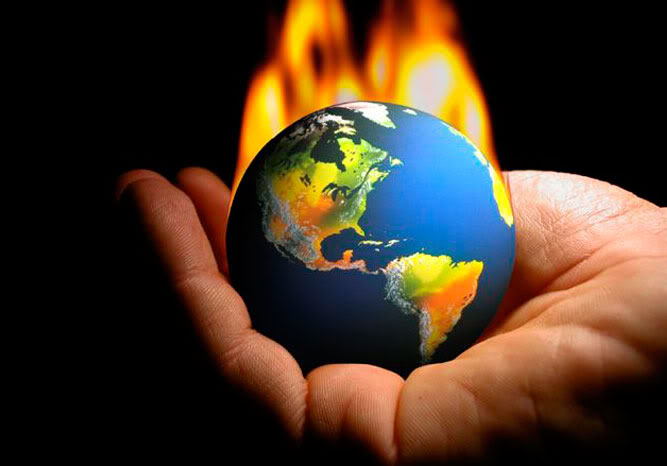|
Volume : V, Issue : XII, January - 2016 GLOBAL WARMING: AN EMERGING THREAT Rajesh Kumari, None DOI : 10.9780/22307850, By : Laxmi Book Publication Abstract : Global warming refers to the rising average temperature of earth’s atmosphere and oceans due to natural or anthropogenic climate change. Global warming is closely linked to the enhanced greenhouse effect which is an increase in the concentration of greenhouse gases(GHG) in the atmosphere leading to an increase in the amount of infrared or thermal radiation near the surface. The enhanced greenhouse effect is leading to rising temperatures, referred to as global warming. Measurements show a global temperature increase of 1.4 °F (0.78 °C) between the years 1900 and 2005. However, for thousands of years now, emissions of GHGs to the atmosphere have been balanced out by GHGs that are naturally absorbed. As a result, GHG concentrations and temperature have been fairly stable. This stability has allowed human civilization to develop within a consistent climate Keywords : Article : Cite This Article : Rajesh Kumari, None(2016). GLOBAL WARMING: AN EMERGING THREAT. Indian Streams Research Journal, Vol. V, Issue. XII, DOI : 10.9780/22307850, http://isrj.org/UploadedData/7703.pdf References : - Bindoff, N.L., et al., in IPCC AR4 WG1 2007. "Executive summary". Chapter 5: Observations: Oceanic Climate Change and Sea Level.
- Crowley, T. J.; North, G. R. (May 1988). "Abrupt Climate Change and Extinction Events in Earth History". Science 240 (4855): 996–1002.
- Harrabin, Roger (1 February 2007). "How climate change hits Indias poor". BBC News.
- Schneider, SH, et al, in IPCC AR4 WG2 2007."19.3.2.1 Agriculture".p. 790.
- Singh, Savindra: Environmental Geography. ed.2011, PryagPustakBhawan, University Road, Allahabad
- US National Research Council (2008) (PDF). Understanding and Responding to Climate Change. Board on Atmospheric Sciences and Climate, US National Academy of Sciences.p. 4.
- Bindoff, N.L., et al., in IPCC AR4 WG1 2007. "Executive summary". Chapter 5: Observations: Oceanic Climate Change and Sea Level.
- Crowley, T. J.; North, G. R. (May 1988). "Abrupt Climate Change and Extinction Events in Earth History". Science 240 (4855): 996–1002.
- Harrabin, Roger (1 February 2007). "How climate change hits Indias poor". BBC News.
- Schneider, SH, et al, in IPCC AR4 WG2 2007."19.3.2.1 Agriculture".p. 790.
- Singh, Savindra: Environmental Geography. ed.2011, PryagPustakBhawan, University Road, Allahabad
- US National Research Council (2008) (PDF). Understanding and Responding to Climate Change. Board on Atmospheric Sciences and Climate, US National Academy of Sciences.p. 4.
- Bindoff, N.L., et al., in IPCC AR4 WG1 2007. "Executive summary". Chapter 5: Observations: Oceanic Climate Change and Sea Level.
- Crowley, T. J.; North, G. R. (May 1988). "Abrupt Climate Change and Extinction Events in Earth History". Science 240 (4855): 996–1002.
- Harrabin, Roger (1 February 2007). "How climate change hits Indias poor". BBC News.
- Schneider, SH, et al, in IPCC AR4 WG2 2007."19.3.2.1 Agriculture".p. 790.
- Singh, Savindra: Environmental Geography. ed.2011, PryagPustakBhawan, University Road, Allahabad
- US National Research Council (2008) (PDF). Understanding and Responding to Climate Change. Board on Atmospheric Sciences and Climate, US National Academy of Sciences.p. 4.
- Bindoff, N.L., et al., in IPCC AR4 WG1 2007. "Executive summary". Chapter 5: Observations: Oceanic Climate Change and Sea Level.
- Crowley, T. J.; North, G. R. (May 1988). "Abrupt Climate Change and Extinction Events in Earth History". Science 240 (4855): 996–1002.
- Harrabin, Roger (1 February 2007). "How climate change hits Indias poor". BBC News.
- Schneider, SH, et al, in IPCC AR4 WG2 2007."19.3.2.1 Agriculture".p. 790.
- Singh, Savindra: Environmental Geography. ed.2011, PryagPustakBhawan, University Road, Allahabad
- US National Research Council (2008) (PDF). Understanding and Responding to Climate Change. Board on Atmospheric Sciences and Climate, US National Academy of Sciences.p. 4.
- Bindoff, N.L., et al., in IPCC AR4 WG1 2007. "Executive summary". Chapter 5: Observations: Oceanic Climate Change and Sea Level.
- Crowley, T. J.; North, G. R. (May 1988). "Abrupt Climate Change and Extinction Events in Earth History". Science 240 (4855): 996–1002.
- Harrabin, Roger (1 February 2007). "How climate change hits Indias poor". BBC News.
- Schneider, SH, et al, in IPCC AR4 WG2 2007."19.3.2.1 Agriculture".p. 790.
- Singh, Savindra: Environmental Geography. ed.2011, PryagPustakBhawan, University Road, Allahabad
- US National Research Council (2008) (PDF). Understanding and Responding to Climate Change. Board on Atmospheric Sciences and Climate, US National Academy of Sciences.p. 4.
|
Article Post Production
No data exists for the row/column.
|